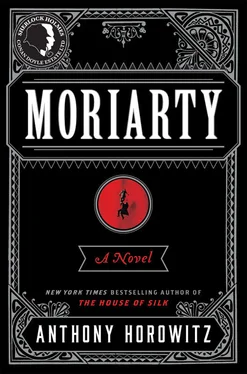From Strasbourg, Holmes continues to Geneva and spends a week exploring the snow-capped hills and pretty villages of the Rhône Valley. Watson describes this interlude as ‘charming’, which is not the word I would have used in the circumstances but I suppose we can only admire the way these two men, such close friends, can relax in each other’s company even at such a time as this. Holmes is still in fear of his life, and there is another incident. Following a path close to the steel-grey water of the Daubensee, he is almost hit by a boulder that comes rolling down from the mountain above. His guide, a local man, assures him that such an event is quite commonplace and I am inclined to believe him. I’ve looked at the maps and I’ve worked out the distances. As far as I can see, Holmes’s enemy is already well ahead of him, waiting for him to arrive. Even so, Holmes is convinced that once again he has been attacked and spends the rest of the day in a state of extreme anxiety.
At last he reaches the village of Meiringen on the River Aar where he and Watson stay at the Englischer Hof, a guest house run by a former waiter from the Grosvenor Hotel in London. It is this man, Peter Steiler, who suggests that Holmes should visit the Reichenbach Falls, and for a brief time the Swiss police will suspect him of having been in Moriarty’s pay—which tells you everything you need to know about the investigative techniques of the Swiss police. If you want my view, they’d have been hard pressed to find a snowflake on an Alpine glacier. I stayed at the guest house and I interviewed Steiler myself. He wasn’t just innocent. He was simple, barely taking his nose out of his pots and pans (his wife actually ran the place). Until the world came knocking at his door, Steiler wasn’t even aware of his famous guest’s identity and his first response after the news of Holmes’s death had been revealed was to name a fondue after him.
Of course he recommended the Reichenbach Falls. It would have been suspicious if he hadn’t. They were already a popular destination for tourists and romantics. In the summer months, you might find half a dozen artists dotted along the mossy path, trying to capture the meltwater of the Rosenlaui Glacier as it plunged three hundred feet down into that ravine. Trying and failing. There was something almost supernatural about that grim place that would have defied the pastels and oils of all but the greatest painters. I’ve seen works by Charles Parsons and Emanuel Leutze in New York and maybe they would have been able to do something with it. It was as if the world were ending here in a perpetual apocalypse of thundering water and spray rising like steam, the birds frightened away and the sun blocked out. The walls that enclosed this raging deluge were jagged and harsh and as old as Rip van Winkle. Sherlock Holmes had often shown a certain fondness for melodrama but never more so than here. It was a stage like no other to act out a grand finale and one that would resonate, like the falls themselves, for centuries to come.
It’s at this point that things begin to get a little murky.
Holmes and Watson stand together for a while and are about to continue on their way when they are surprised by the arrival of a slightly plump, fair-haired fourteen-year-old boy. And with good reason. He is dressed to the nines in traditional Swiss costume with close-fitting trousers tucked into socks that rise up almost to his knees, a white shirt and a loose-fitting red waistcoat. All this strikes me as a touch incongruous. This is Switzerland, not a Palace Theatre vaudeville. I feel the boy is trying too hard.
At any event, he claims to have come from the Englischer Hof. A woman has been taken ill but refuses for some reason to be seen by a Swiss physician. This is what he says. And what would you do if you were Watson? Would you refuse to believe this unlikely story and stay put or would you abandon your friend—at the worst possible time and in a truly infernal place? That’s all we ever hear about the Swiss boy, by the way—although you and I will meet him again soon enough. Watson suggests that he may have been working for Moriarty but does not mention him again. As for Watson, he takes his leave and hurries off to his non-existent patient; generous but wrong-headed to the last.
We must now wait three years for Holmes’s reappearance—and it is important to remember that, to all intents and purposes, as far as this narrative is concerned, it is believed that he is dead. Only much later does he explain himself (Watson relates it all in ‘The Adventure of the Empty House’), and although I have read many written statements in my line of work, few of them have managed to stack up quite so many improbabilities. This is his account, however, and we must, I suppose, take it at face value.
After Watson has left, according to Holmes, Professor James Moriarty makes his appearance, walking along the narrow path that curves halfway around the falls. This path comes to an abrupt end, so there can be no question of Holmes attempting to escape—not that such a course of action would ever have crossed his mind. Give him his due: this is a man who has always faced his fears square on, whether they be a deadly swamp adder, a hideous poison that might drive you to insanity or a hell-hound set loose on the moors. Holmes has done many things that are, frankly, baffling—but he has never run away.
The two men exchange words. Holmes asks permission to leave a note for his old companion and Professor Moriarty agrees. This much at least can be verified for those three sheets of paper are among the most prized possessions of the British Library Reading Room in London where I have seen them displayed. However, once these courtesies have been dispensed with, the two men rush at each other in what seems to be less a fight, more a suicide pact, each determined to drag the other into the roaring torrent of water. And so it might have been. But Holmes still has one trick up his sleeve. He has learned bartitsu . I had never heard of it before but apparently it’s a martial art invented by a British engineer, which combines boxing and judo, and he puts it to good use.
Moriarty is taken by surprise. He is propelled over the edge and, with a terrible scream, plunges into the abyss. Holmes sees him brush against a rock before he disappears into the water. He himself is safe… Forgive me, but is there not something a little unsatisfactory about this encounter? You have to ask yourself why Moriarty allows himself to be challenged in this way. Old-school heroics are all very well (although I’ve never yet met a criminal who went in for them) but what possible purpose can it have served to endanger himself? To put it bluntly, why didn’t he simply take out a revolver and shoot his opponent at close range?
If that is strange, Holmes’s behaviour now becomes completely inexplicable. On the spur of the moment, he decides to use what has just occurred to feign his own death. He climbs up the rock face behind the path and hides there until Watson returns. In this way, of course, there will be no second set of footprints to show that he has survived. What’s the point? Professor Moriarty is now dead and the British police have announced that the entire gang has been arrested so why does he still believe himself to be in danger? What exactly is there to be gained? If I had been Holmes, I would have hurried back to the Englischer Hof for a nice Wiener schnitzel and a celebratory glass of Neuchâtel.
Meanwhile, Dr Watson, realising he has been tricked, rushes back to the scene, where an abandoned alpenstock and a set of footprints tell their own tale. He summons help and investigates the scene with several men from the hotel and a local police officer by the name of Gessner. Holmes sees them but does not make himself known, even though he must be aware of the distress it will cause his most trusted companion. They find the letter. They read it and, realising there is nothing more to be done, they all leave. Holmes begins to climb down again and it is now that the narrative takes another unexpected and wholly inexplicable turn. It appears that Professor Moriarty has not come to the Reichenbach Falls alone. As Holmes begins his descent—no easy task in itself—a man suddenly appears and attempts to knock him off his perch with a number of boulders. The man is Colonel Sebastian Moran.
Читать дальше












